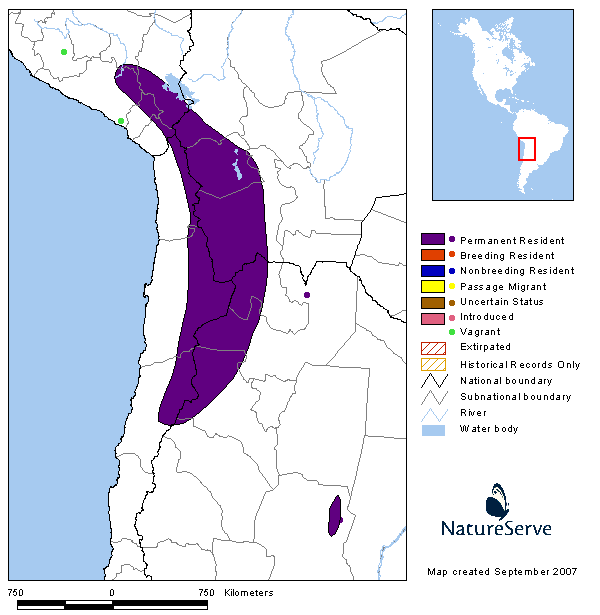James's Flamingo
They are also known as the Puna flamingo, is a species of flamingo that populates the high altitudes of Andean plateaus of Peru, Chile, Bolivia, and northwest Argentina . It is named for Harry Berkeley James, a British naturalist who studied the bird. They are closely related to the Andean flamingo. They have a very long neck made up of 19 long cervical vertebrae, allowing for of movement and rotation of the head. The knee is not visible externally, but is located at the top of the leg. The joint at the middle of the leg, which most assume to be the knee joint, is actually the ankle joint. Its plumage is a very pale pink.

They have bright carmine streaks around their neck and back. When pershed you can see a small amount of black in the wings, these are the flight feathers. They have bright red skin around their eyes, which is yellow in adults. Their legs are brick red and their bill is bright yellow with a black tip.
Habitat
James's flamingo occupies the continent South America in the high altitudes of Andean plateaus of Peru, Chile, Bolivia and Argentina. It inhabits highland salt lakes with soft substrate and relatively sparse vegetation. It breeds on islets or islands of sand or soft clay, and along the shores of salt lakes.
Diet

They are herbivores and there main food source is microscopic plankton such as diatoms. The sizes of the diatoms associated with this size filtering apparatus are about 21-60 μm. Diatoms this size are typically found close to the edge of the water; even in colonies of multiple species, James's flamingos typically feed in the region closest to the edge of the water. The birds are able to use their webbed feet to help kick up microscopic algae if not enough are floating in the water columns.
Breeding
They are monogamous and form strong pairs that may last for many years. They usually engage in collective displays with a series of ritualized movements and postures. During such displays their pair-bonds are formed. The mating season is from January to March. These flamingos nest in large colonies, often together with other South American flamingos. The parents build the nest together and a single egg is laid. Incubation starts immediately, is shared by both parents and lasts 27 to 31 days. Once the chick first hatches, it is fed "crop milk", which is from the upper digestive tract of the parents. When chicks are able to walk, they join together in crèches, watched over by several adult birds. When it is three months old, the chick can survive independently without help from the parents. Young flamingos reach sexual maturity within about 3 to 4 years and develop full adult plumage.
Population
The population is estimated to number 106,000 individuals based on coordinated census in 2010. Trends since the 1990s have been positive, indicating the start of a recovery, and census data suggest that the population may have stabilised. Despite this, it is suspected that the population will undergo a moderately rapid decline over the next three generations owing mainly to habitat loss and degradation.
Threats
Levels of diatoms may be affected by climate change to the detriment of flamingo food resources. Egg-collecting and hunting were intensive during the 20th century, but have been controlled in protected areas. Mining activity and the associated demand for water, as well as tourism are further threats to some wetlands.
Conservation
Conservation Actions Underway
The key protected area is Eduardo Avaroa National Faunal Reserve, Bolivia. International and national conservation programmes have been organised in all four countries, and will hopefully continue to encourage population growth.
Conservation Actions Proposed
Continue simultaneous surveys during breeding season to monitor population. Increase network of protected areas to include vital sites in Argentina. Investigate feasibility of creating a trinational reserve integrating management of sites in Argentina, Bolivia and Chile to protect key breeding colonies and congregation sites .